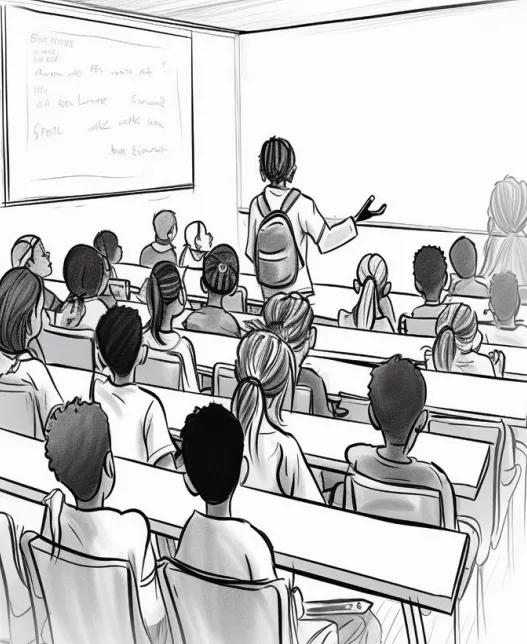Education is lifelong. At each stage of our life, it impacts our progression, helping us evolve in response to changing trends. In education, spotlight turns to teachers.
The landscape of education and teaching methodologies has undergone significant transformation. Teaching now demands a nuanced blend of both technical and non- technical skills.
Generally, in our state and similar regions, teachers are often assessed based on certifications. However, true test emerges when these skills are put into action in the day-to-day work environment.
Various constraints such as time limitations and the urgency to complete syllabi before summative exams or school policies etc. contribute to multifaceted challenges faced by educators.
An organised study of numerous teaching strategies and practices aims to create a favourable environment for both students and teachers, preventing educators from getting overwhelmed with course content and syllabi.
The process ideally begins with a meticulous review of the curriculum standards set by the school or government and concludes with the collection of qualitative and quantitative data, followed by feedback disseminated to all stakeholders involved in the education process.
On the contrary, educators dive into their teaching duties without delving into the intricacies of such details.
The above discourse highlights the critical importance of a well-constructed lesson plan—a comprehensive guide outlining the learning trajectory, providing invaluable steps towards accelerating learning with a meaningful teaching.
The main purpose of such plan is to help teachers steer the class and its learners, ensuring they can achieve the desired learning outcomes through channelling their efforts and resources.
The prevailing culture of cover- to-cover teaching, meaning completing the syllabus from start to finish within stipulated timeframes and often restricting the teaching to the course book, might be deemed ineffective.
Constructing a robust lesson plan is imperative for creating alignment across lessons and designing an effective teaching methodology. It not only reinforces the teacher’s confidence during instruction but also ensures time management.
Mapping the instruction methodology that is engaging and efficient with the intended level of learning for the learners, and then designing activities that contribute directly to achieving the learning objectives, will ensure the relevance of these plans.
Teachers must question themselves about the rationale behind learning or understanding a concept, topic, or subject and its real-world applications. Determining the end goal for the lesson and visualizing success in terms of assessments are crucial steps in this process. Subsequently, listing the activities and projects that would contribute to mastery in the learning experience becomes paramount.
Then jotting down the learning outcomes involves meticulous scrutiny to ensure their relevance, achievability, measurability and demonstration, and alignment with taxonomies such as Blooms taxonomy.
Planning specific activities, including lecturing, quizzes, drills and practices, student presentations, simulations, games, feedback sessions, debates, and seeking feedback, must be chosen beforehand.
The final item in the lesson planning process involves planning assessments to measure mastery using various methods such as rubrics, self-assessment, peer assessment, pen-and-paper assessments, pop quizzes, checklists, maps, and organizers.
Designing a realistic timeline for all trajectories and components of the lesson plan is crucial for its flawless execution.
The lesson plan concludes with a reflective closure, where the teacher assesses understanding, acknowledges success, provides a preview of the next topic, and summarizes and reviews all aspects considered during the lesson.
This could be well organised by maintaining a personal journal. In this space, the teacher can document everything that worked well, areas that could be improved and how those improvements could be achieved.
This way, educators can refine their teaching methodologies and enhance their overall effectiveness of instruction.
The practical application of certain theories on classroom learning can add another layer of complexity and depth to teaching:
Theories such as cognitivism, behaviorism, constructivism, social learning theory, or connectivism offer valuable insights into understanding the child or student and the various aspects of learning necessary for knowledge acquisition and accomplishment.
Furthermore, considering differentiation in the lesson can be a powerful tool for teachers to cater to the diverse needs, readiness, interests, and learning styles of students.
Differentiation involves introducing and incorporating various teaching practices, methodologies, and strategies driven by students’ learning styles and individual requirements.
Recognizing that every individual possesses a distinct learning style is crucial. These learning styles inform educators about how individuals observe, process, retain, and apply knowledge and skills differently.
Several modalities can be employed by teachers to gauge learners’ learning styles, such as the VARK modality, which defines four sensory modalities: visual, auditory, read/write, and kinesthetic. Kolb’s learning style model is another framework that can be utilized to understand the continuum of the learning process: feeling, watching, thinking, and doing. The teacher must discern which modality to choose to segregate the children based on different learning styles so that teaching strategies can be implied based on their learning styles.
With the advent of technology and evolution in the approach to teaching, education has become more student-centric, with a focus on learning rather than on content. This shift in focus has prompted professionals in education to adopt an approach based on learning outcomes.
Once the learning outcomes are identified, teachers know the milestones their students are expected to achieve in the stipulated time. Learning taxonomies are approaches that curriculum developers can take to formulate learning outcomes that are expected to be achieved by the students.
Continual reflection, adaptation, and integration of diverse pedagogical tools will ensure that education remains as an evolving process, continuously equipping learners with the skills and knowledge essential throughout their journey of life.
The author, holds certifications as a corporate trainer in both English and French.






